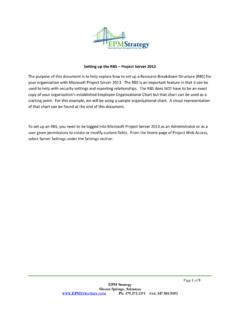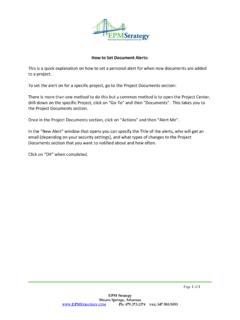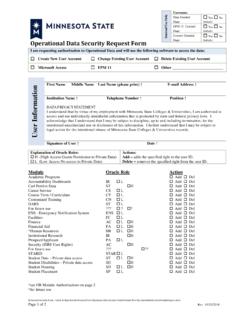Transcription of DURATION vs UNITS vs WORK - EPM Strategy
1 Page 1 of 17 EPM Strategy Siloam Springs, Arkansas Ph: FAX: DURATION vs UNITS vs work (And, effort driven scheduling) Prepared by Collin Quiring The goal of this document is to try and explain a very complicated topic how task types affect a schedule. Task types are not unique to Microsoft Project but this document discusses task types from the Microsoft Project perspective. In Microsoft Project, we have the ability to mix the task types. I generally recommend against this due to sheer complexity of managing this methodology.
2 Microsoft Office Project uses one of three task types to calculate the DURATION of tasks and subsequently their finish dates (or their start dates if you schedule your project from the project finish date rather than the project start date). The three types of tasks are: Fixed DURATION , Fixed UNITS and Fixed work , often referred to just as DURATION , UNITS and work . At its most basic, the Collin definitions of these are: DURATION : The overall amount of time given to accomplish a task usually measured in days. UNITS : How much of their total available time a resource gives to a task usually measured in percentage.
3 work : The amount of time that it takes to do actually do the task usually measured in hours. Most companies as a whole and individuals in particular, tend to think of and use DURATION as an intuitive task type. People generally consider only the amount of time that a person/ unit /department has to complete a task they don t generally consider the effect of specific people or the affect of how much effort ( UNITS ) those people can give. We tend to measure DURATION in whole days . For example, we often say that a certain task will take 40 days.
4 We don t generally say that a task will take 1600 hours or that a resource has 20 hours of work in 40 days . Here is an example with explanation: If I tell you that I will work one normal work day, all day, devoted to your task, then I am saying that I have DURATION of one day, work of 8 hours, and 100% of my UNITS . But, if I tell you that I will accomplish your task in one day, but I will only spend half my time on it, then I am saying that DURATION is one day, work is 4 hours, and you are only getting 50% of my UNITS during that one day DURATION .
5 More detailed explanations and examples are given below but this is a rough framework of how to think of DURATION , UNITS and work . And, the wrinkle of adding Effort Driven Scheduling is explained, starting on page 12. Page 2 of 17 EPM Strategy Siloam Springs, Arkansas Ph: FAX: Definitions and Quick Explanation A single task must be set in Microsoft Project to be either Fixed DURATION , Fixed UNITS or Fixed work but a task can only have one of those designations. Different tasks within the same schedule can be different task types though.
6 Therefore, we need to look specifically at how the system defines these task types. Here are two sets of definitions to further clarify (or muddy??) the Collin definitions as written above. The first definition is from Microsoft and then the second one is taken from Project Bible (Microsoft Office Project 2003 Bible, written by Elaine Marmel). Microsoft Definition: Fixed DURATION A task in which the DURATION is a fixed value and any changes to the work or the assigned UNITS [that is, resources] don't affect the task's DURATION .
7 Project Bible Definition: Fixed DURATION The number of resources does not affect the timing of this type of task. To allow a week for a committee to review the company s new ad campaign not matter how many people are on the committee give the task a fixed DURATION . You can t shorten the task s DURATION by adding resources to it. Microsoft Definition: Fixed UNITS - A task in which the assigned UNITS [or resources] is a fixed value and any changes to the amount of work or the task's DURATION do not affect the task's UNITS .
8 Project Bible Definition: Fixed UNITS Resource driven tasks are referred to as fixed- unit tasks. Here s a simple example. You have to plant a tree. One person needs two hours to plant a tree. If you add another person (another resource), together they need only one hour to complete the task. That is, two resources, each putting in an hour of effort, complete the two hours of work in only one hour. With resource-driven scheduling, when you add resources, the task DURATION becomes shorter; if you take away resource, the task takes longer to complete.
9 And, on the flip side, the resource assignments to a task don t change when the work increases or decreases. (Note: This is a strict math calculation in Project. Ten people get the work done in 1/10th the amount of time there are no calculations for efficiency or other variables.) Microsoft Definition: Page 3 of 17 EPM Strategy Siloam Springs, Arkansas Ph: FAX: Fixed work - A task in which the amount of work is a fixed value and any changes to the task's DURATION or the number of assigned UNITS [or resources] do not affect the task's work .
10 Project Bible Definition: Fixed work When you create a fixed- work task, you set the DURATION of the task, and Project assigns a percentage of effort that is sufficient to complete the task in the time that is allotted for each resource that you assign to the task. For example, if you assign three people to work on a one-day task, Project would say that each person should spend 33 percent of his or her time on the task to complete it in one day. Similarly, a task may take 48 hours to complete (its fixed- work value).











